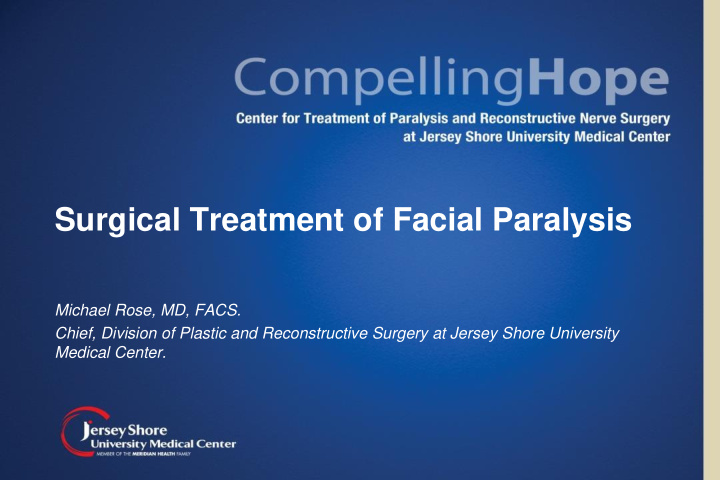



Surgical Treatment of Facial Paralysis Michael Rose, MD, FACS. Chief, Division of Plastic and Reconstructive Surgery at Jersey Shore University Medical Center.
Peripheral Nerve Surgery Spinal Cord Injury Disorders of Stroke Peripheral Nerves Peripheral Nerve Surgery Nerve Regeneration
Peripheral Nerve Surgery Applications Peripheral Nerve Spinal Cord Stroke Disorders Injury • Compression • Tetraplegic hand • Upper extremity Neuropathy • Pressure sores paralysis • Facial Paralysis • Aspiration • Ventilator • Phantom Limb dependency pain • Bladder • Nerve Trauma dysfunction
Brachial Plexus Repair Facial Reanimation Prostate Grafting Foot Drop Surgery Nerve Transplantation Reanimation After Spinal Cord Injury Reanimation After Stroke Resensitization of the Buttocks
Can Be Fixed Primary Repair Nerve Grafting Neurotization Free Muscle Flap
NEURAPRAXIA Stretching of nerve Results in nerve dysfunction Demyelination Function returns by 3 months NEUROTMESIS Significant nerve damage Nerve division No recovery Nerve repair required
Facial Paralysis Trauma Cancer Stroke Bell’s Palsy
Facial Nerve Function • Motor Accessory Auditory Accessory Masticatory Facial Expression • Secretory Lacrimal Parotid Submandibular/Sublingual • Afferent from Taste Fibers Traumatic Neoplastic Congenital
Examination • Central Paralysis movements of the upper face tend to be spared emotional expression may be present lacrimation and salvation may be present involvement of the tongue • Peripheral Paralysis less prominent wrinkles/nasolabial fold, brow droop unable to wrinkle forehead or purse lips bell phenomenon
Surgical Intervention • Direct nerve anastomosis • Interpositional nerve grafts • Anastomosis to other nerves • Dynamic musculofascial transpositions • Static musculofascial transpositions • Microvascular reanimation • Other facial corrective procedures
Nothing by EMG or clinically at 3 months
Minimal Progress by EMG or clinically at 6 months
Not completely improved by 9 months
Muscle transposition • Temporalis • Masseter
Crossover Techniques • Irreversible nerve injury • Intact motor endplates • Intact mimetic function • Intact proximal donor nerve • Intact distal facial nerve
LATE CROSS-FACIAL NERVE GRAFTING AND FREE MUSCLE TRANSFER
Summary 1) Many etiologies 2) Many treatment options 3) Etiology often drives treatment decisions 4) Can be a long process with multiple steps 5) Results are variable but can be very rewarding 6) Adjunctive treatments are helpful (biofeedback, botox injections, static lifts and “tucks”, eyelid weights etc) 7) Procedures have been refined over the years with microsurgical advances, but future treatments may be able to restore function more reliably (Stem cells, nerve regrowth research, tissue engineering etc)
THANK YOU Michael Rose, MD, FACS. Chief, Division of Plastic and Reconstructive Surgery at Jersey Shore University Medical Center.
Recommend
More recommend